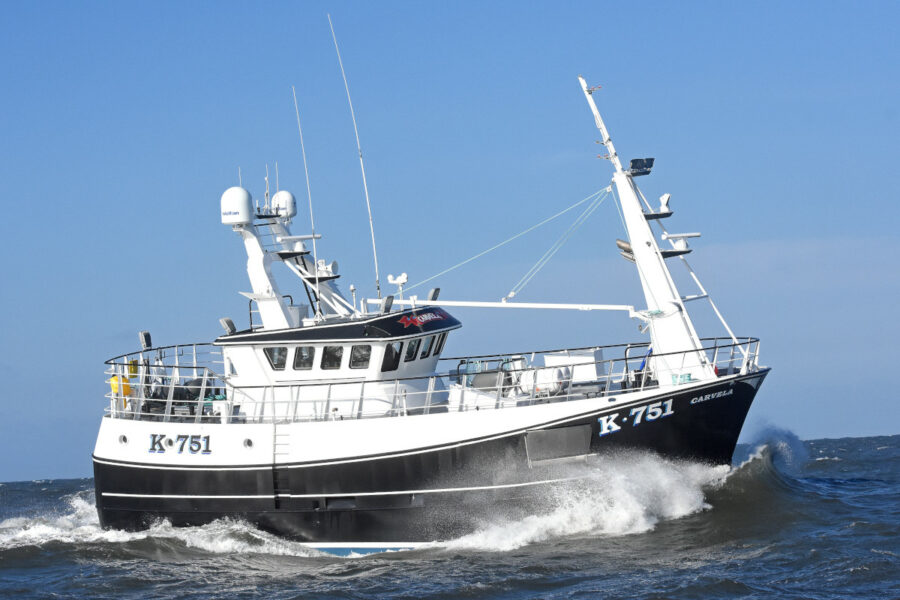The spells of poorer weather that have been experienced on a fairly regular basis since the new 19m vivier-crabber Carvela K 751 was handed over to family company Celtic Dawn Fishing of Birsay, Orkney, at the beginning of the summer, have provided a number of early opportunities for the owners to assess the vessel’s fishing capabilities, reports David Linkie
Skipper Scott Norquoy, together with his father and relief skipper Ronnie Norquoy, report that Carvela is proving to be well-suited to the task of fishing weekly trips in the northwesterly quadrant up to 80 miles from Stromness.
From Carvela’s maiden trip towards the end of May, periods of scruffy weather have been the norm rather than the exception most weeks, including winds of up to 40 knots on occasions, as the skippers and crew familiarised themselves with the crabber’s working characteristics.

Forward view of Carvela.
Although more prolonged periods of challenging conditions, including characteristically deep North Atlantic swells, are expected to be encountered as the days continue to shorten, marking the onset of winter, the owners are confident that Carvela will meet their expectations and fully justify the decision to invest in a new vessel.
Fishing down to 50-60 fathoms, Carvela works strings of 100 26in double soft-eyed D-section crab creels manufactured by Gael Force, Medley Pots and Caithness Creels. Fitted with sheet plastic bases, the creels are spaced at 17-fathom intervals on Gael Force Super SeaKing XL leaded 16mm-diameter backropes.
Brown crab, landed at the beginning of each week, are either weighed onto a vivier truck on the new pier at Stromness, or delivered the short distance along the road to the Orkney Fishermen’s Society’s processing factory.

Pumping out the vivier hold in preparation for Carvela…
On delivery later in the day to shellfish merchants in the UK, the majority of the hen crabs are immediately packed into 20kg polystyrene boxes, along with gel packs, for delivery by air to live markets in China within 48 hours of being taken out of Carvela’s vivier hold.
The location of Orkney means that Carvela’s arrival, and that of the vivier lorry, need to be carefully co-ordinated, in line with ferry timetables across the Pentland Firth to Caithness. With costly delays needing to be avoided, transport logistics form a key part of the owners’ continually busy weekly schedule.
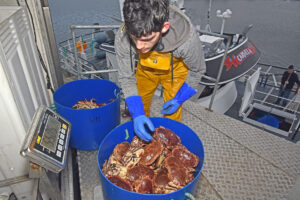
… landing at Stromness.
As soon as the shellfish are landed, cartons of frozen bait are brought down to the pier on pallets from Celtic Dawn Fishing’s freezer store, and loaded into the bait room as the crew prepare for the next trip.
Optimising crew comfort and safety, in tandem with fishing efficiency and economical operation, were key factors behind the owners’ decision to place the order for the new boat with Parkol Marine Engineering, nine years after the Whitby boatbuilder completed the 18.50m vivier-crabber Nórønya K 733 for Celtic Dawn Fishing in 2008.
Built four years after the 16.95m Celtic Dawn II K 76, Nórønya featured a totally new concept of internal layout that facilitated the substantial enlargement of both the crew’s accommodation areas and the working area on the main deck.
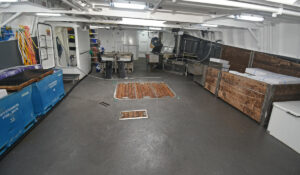
General view of Carvela’s extensive main deck…
In essence, this design featured positioning the galley and messdeck area below the main deck, rather than on it, thereby maximising the working area available on the main deck. This significant development facilitated the owners’ requirement for the maximum possible amount of working flexibility, and storage area, on the main deck.
The degree to which these arrangements proved practical and successful is shown by the fact that Nórønya was used as the starting point for the design process that led to Carvela.
While in broad brush terms, Carvela features a generally similar internal layout, any similarities between the two vessels end there, as in terms of detail, Carvela is a totally different boat, featuring a combination of new ideas.
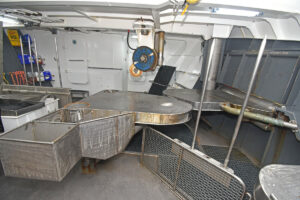
… and a detailed view of the self-hauling arrangements.
These reflect the countless hours of thought that the owners invested in the design process, in order to achieve a streamlined modern profile at the same time as maximising the working area on the main deck and the internal area below it.
From the high-tech Luminell flood and search lights mounted on the foremast, to the wood-grained doors in the accommodation areas, the owners have taken every opportunity to source modern products to enhance both the appearance and the functionality of Carvela.
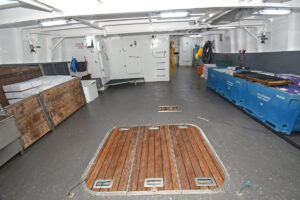
Looking aft on the main deck.
In terms of crew and vessel safety, the presence of dedicated separate hauling and shooting hatches forward to starboard, and a viewing tunnel thorough the enclosed shelterdeck that provides the skipper with a clear view of pots at the gunwale rail roller, are key features of the working arrangements.
So too are two large hydro-electric power packs in the forward engineroom that drive the hydraulic deck machinery. Designed by Eunan Kennedy of Killybegs specialist EK Marine, the fully integrated system provides optimum levels of operational flexibility and reliability.

From the skipper’s seat in the wheelhouse…
Carvela was built and fully fitted out in Parkol’s large fabrication hall at Middlesbrough. After being lifted into the river Tees, Carvela steamed to Whitby in fresh weather for final commissioning, before steaming home to Stromness via Peterhead and Scapa Flow.
Designed by Ian Paton of SC McAllister, the main dimensions of Carvela are LOA 19m, registered length 16.49m, beam 6.8m, depth moulded 4.20m and GT 152.12t. Of round bilge form, the steel hull incorporates a semi-bulbous bow, raked soft-nose stem and transom stern, the corners of which are well-rounded to enhance manoeuvrability, both in harbour and when keeping station to the gear while hauling.
The benefits of finer bow sections above and below the water are reported to be proving beneficial, in terms of steaming performance, fuel economy, and delivering a well-cushioned ride when hauling and steaming into weather.
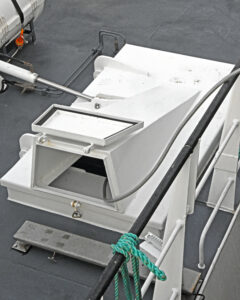
… a hatch on top of the shelterdeck…
Below main deck level, the hull is arranged into a forward engineroom, central vivier trunking with a large terraced bait store to starboard, galley/messdeck amidships, and accommodation cabins aft.
With the exception of an elongated deckhouse aft on the starboard side, the main deck is dedicated to fishing operations, with over 85m² of flush deck area available, giving maximum storage and working flexibility.
Two watertight doors arranged across the fore end give access to the deckhouse, either directly to a lobby area leading up to the wheelhouse or down to the main accommodation areas, or via a walk-through compartment parallel to the vessel’s starboard side. As well as heated oilskin storage and glove/boot drying facilities, this area includes bench seating and tea/coffee-making facilities.
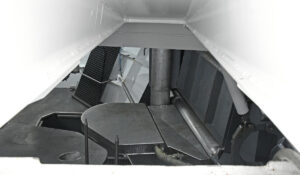
… provides a clear view of hauling activities forward on the main deck.
A large shower room is arranged across the full width of the deckhouse. Laundry facilities are located in the adjacent lobby area. Additional toilet facilities are provided in a compartment on the port quarter of the main deck.
An easy-access companionway leads downwards and forward from the deck casing to a lobby area below the main deck, leading to the galley/messdeck and the accommodation cabins.
Twin mess tables are surrounded by bench seating along Carvela’s port side. The well-equipped galley straddles the vessel’s centreline. Light-coloured natural wood laminates enhance the open-plan layout of the galley/messdeck, which was designed to give a modern spacious appearance.
Similar principles prevail in the sleeping accommodation which, from a central access point, is subdivided into twin two-berth cabins forward of two three-berth cabins arranged either side of the compartment housing the Wills Ridley steering gear.
The owners’ attention to detail, evident throughout Carvela, is epitomised by the stylish wave-profiled bunks and the stainless steel-edged wood-laminate doors in the central passageway, which contribute to a modern homely feel.
Crabbing arrangements
The highly repetitive nature of offshore crabbing means that any potential benefits, no matter how minor they may seem at first, whether in terms of time or physical effort required, accumulate over the course of the day to the mutual benefit of skipper and crew.
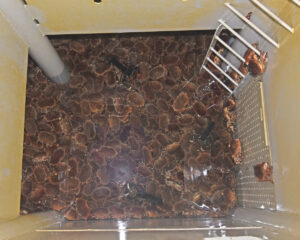
Starting to pump out the vivier hold, which extends aft under the floor of the galley/messdeck from the central trunking section.
This realisation was central to the finely tuned working arrangements that are now proving to be highly effective on Carvela, which features a self-hauling system and two locations for re-toggling creels onto the backropes. The owners opted for a toggle system to give maximum working flexibility, and because it is easier on the potting gear as well as the boat itself.
The benefits of being able to work in poor weather under an enclosed shelterdeck are already fully appreciated by the crew. The main reason for this is the provision of a small viewing hatch, through which the skipper can constantly monitor hauling activity at the rail through the shelterdeck.
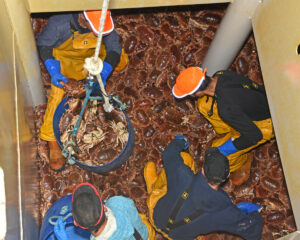
Crewmen filling bongos with female brown crab…
The raised viewing opening is incorporated into the aft end of an elongated hatch positioned along the starboard side of the vessel forward of the wheelhouse. In fine weather, the hydraulically operated hatch can be opened to provide conventional sight of hauling operations.
A further two hydraulically operated and relatively small hatches are arranged in the starboard side of the hull.
The larger of these is positioned directly above the large-diameter stainless steel gunwale roller. In order to eliminate discolouration of the hull paintwork at the hauling position, stainless steel has been used to plate the hull below the gunwale roller to the waterline.
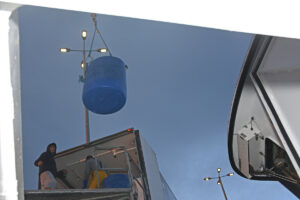
… before they are…
A smaller shooting hatch is arranged slightly further aft, parallel to the re-toggling table.
Together, these arrangements ensure that when fishing in heavy weather, only one hatch needs to be open.
Carvela uses a 2t Britannia slave hauler for hauling her gear. The hauler is mounted on a hanging box on the underside of the shelterdeck, fitted inboard of the large-diameter stainless steel gunwale and forward vertical rollers, which guide creels onto the first of two stainless steel clearing and baiting tables.
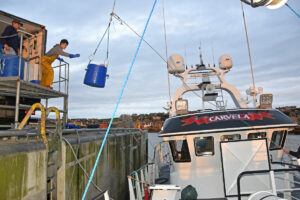
… swung ashore…
The customised hanging box was manufactured by Dave Hourston of Hamnavoe Engineering, Orkney, with the capability of being fully adjustable, both in terms of sliding and swivelling.
The pivoted drop-down creel receiving table is separated from the inboard clearing and rebaiting table by a small parallel gap, allowing the backrope to be flaked into a large storage compartment below the level of the main deck. Built into the deck structure, this arrangement significantly reduces the amount of rope lying on deck.
When the creels are emptied, undersized and white crab are returned to the seabed from the clearing table via an adjacent vertical pipe that leads straight down through the vessel’s engineroom before exiting the hull near the keel.

… before being weighed and transferred to storage tanks.
Selected brown crab are passed across to a storage table, where they are nicked by one of two crewmen sitting on the aft side of it, before being placed into one of two chutes leading to the vivier hold. The availability of two chutes allows catch segregation, in relation to catch patterns and market requirements.
Capable of holding 49t of shellfish and seawater, the vivier hold is subdivided into one-quarter and three-quarter compartments, with the smaller section located to starboard.
Seawater in the vivier hold is changed every 10 minutes by one of two 6in Azcue electrically driven 7kW pumps.
Aft of the central trunking section, the vivier hold extends aft under the floor of the accommodation area amidships, where it is flanked by double wing fuel tanks, which have a joint capacity of 13,300 litres. By being positioned about the crabber’s longitudinal centre of flotation, this arrangement ensures that Carvela does not change trim much between full and empty tanks. As crab is only slightly heavier than the water it displaces, the boat does not become much heavier when loaded.
After being untoggled from the backrope, cleared and rebaited, creels are stacked four high in four tiers across the main deck amidships. When Carvela is running gear, the creels are placed on a shooting table aft of six toggle bars, from where the short legs are reattached as the creels pass over the gunwale rail.
The efficiency of this working arrangement and an experienced crew is shown by the fact that a leader of gear is usually back in the water within 40 minutes of the start of hauling.
A second set of toggle bars and a gunwale-height shooting platform are arranged to starboard of the crabber’s centreline aft. This will be used mainly after several fleets of gear have been taken onboard, before Carvela moves to fresh crab grounds.
In this mode of operation, backropes are hauled aft through a small-section chute leading through the deck casing, and flaked down into a large deck pond by a rope puller mounted on the underside of the shelterdeck. A screen positioned nearby enables the crewman operating the rope hauler to constantly monitor activity forward on the main deck via the vessel’s CCTV system.
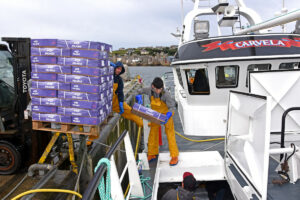
Taking cartons of frozen herring aboard Carvela…
The transfer of pots from the main deck upwards to the additional gear storage area on the shelterdeck abaft the wheelhouse is facilitated by a small winch and horizontal lifting derrick positioned on the aft side of the wheelhouse, directly above an access hatch.
Twenty-kilogram cartons of frozen herring and whitefish frames are stored in an insulated bait room located to starboard of the central vivier trunking that extends aft along the side of the galley. The bait store was insulated and GRP-lined by Gerry Smyth and his team from Kilkeel.
Engineroom
The high level of electrically driven ancillary machinery is a key feature in Carvela’s forward engineroom. The owners specified this arrangement in order to deliver consistent operational efficiency, particularly for the pot hauler, and to reduce maintenance requirements.
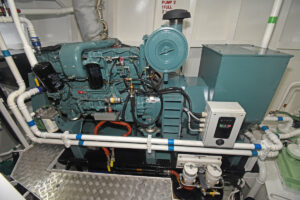
One of the two Mitsubishi 6D16 auxiliary engines that run the Stamford 120kVA generators.
The Dutch company Padmos supplied three Mitsubishi main and auxiliary power units, further strengthening the working relationship that the yard has developed with the Stellendam company in recent years.
Dedicated to propulsion duties, the Mitsubishi SA6A3 MPTAW main engine develops 360kW @ 1,800rpm and drives a 1,900mm-diameter fixed-pitch four-bladed open propeller through a Reintjes WAF 274 7.049:1 reduction gearbox. The centreline package is reported to be well-suited to the underwater hull form, both in free-running performance and fuel economy, with Carvela typically using around 4,000 litres during the course of a six-day week.

The Sole Diesel 19.5kW genset.
Main electrical power on Carvela comes from twin Mitsubishi 6D16 auxiliary engines driving 120kVA Stamford 415/3/50 generators. The electrical distribution cabinets are arranged to port, effectively abaft the engineroom, in the area that houses the bait store on the starboard side.
Additional electrical power is provided by a Sole Diesel 25T 19.5kW genset, installed as a precautionary back-up in the unlikely event of both the main generators going down at sea.
Carvela uses shore power when lying at the new pier in Stromness between trips.
Pearson Electrical of Hull was subcontracted by Parkol Marine Engineering to undertake the electrical installation work on Carvela alongside the boatyard’s own electricians.
One Vikron 80-amp charger is fitted to charge the two sets of batteries in the engineroom. A similar Vikron charger is situated in the wheelhouse to serve the lighting batteries, in addition to a 50-amp GMDSS charger.
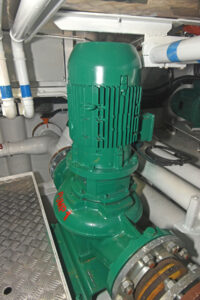
Six-inch diameter Azcue pumps, driven by 7.5kW electric motors, change the seawater in the vivier hold six times an hour.
Cooling for all four engines and the hydraulic system is provided through NRF box coolers arranged across the aft end of the engineroom. Stainless steel CuNiFe piping is used extensively throughout the engineroom.
Hydraulic power for the deck machinery is supplied by two electrically driven 45kW power packs, installed as part of a fully integrated system designed by Killybegs specialist EK Marine. The skipper has full control of the electro-hydraulic system, together with the various hatches, from a console-mounted panel at the fishing position in the wheelhouse.
A hydraulically powered Kort bow thruster of 90kW is fitted to give maximum vessel manoeuvrability in restricted areas.
Wing tanks situated amidships between the hull sides and the vivier tank carry 13,300 litres of fuel. The main 5,800-litre freshwater tank lies to port amidships. A further 4,300 litres of freshwater is carried in two additional tanks situated aft at the quarters.
Echomaster Marine wheelhouse electronics package
Carvela’s wheelhouse, both in terms of general layout and high quality of finish, underlines the attention to detail that the owners gave to the design and fit-out of the vivier-crabber.
The streamlined appearance of the round-fronted wheelhouse is further enhanced by the presence of a double-leg curved gantry aft on the wheelhouse roof, which provides a wide surface area on which to mount the usual array of satellite domes, antennae/whips and radar scanner.
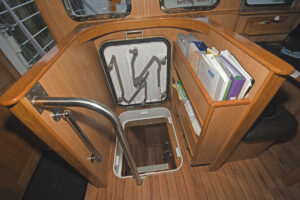
The horseshoe trap.
Slightly offset to starboard atop the shelterdeck, Carvela’s wheelhouse provides skippers Scott and Ronnie Norquoy with a commanding view of hauling and shooting operations on the main deck from the deck-track NorSap helmsman’s chair mounted in the forward starboard corner. Electronic controls for the Britannia hauler are conveniently located to the right of the skipper’s seat, with engine controls on a small pedestal to port.
A second NorSap seat lies to port, forward of hot drink-making facilities and a desk area with a laptop.
The skilled use of solid oak facings, matching light-coloured laminates co-ordinated with contrasting horizontal surfaces, and radiused corners combines to create a modern appearance, in which all available space is fully used.
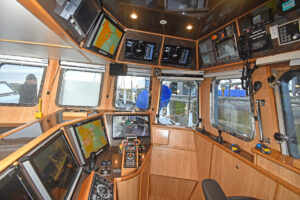
The main console area in the wheelhouse.
This is perhaps best illustrated by the horseshoe surround fitted above the trap, the port side of which is racked for the secure storage of reference booklets and files.
Another example is the control panels for the Luminell flood and search lights, positioned within comfortable reach of the hauling position. Because securing visual sight of buoys is a key requirement of efficient pot hauling, the owners searched the web for high-tech lighting equipment. This resulted in Luminell AS of Aalesund, Norway supplying the powerful cluster of LED floodlights and the double-beam searchlight mounted towards the top of the foremast.
The search light can be focused and fine-tuned to prevailing sea and weather conditions, with the owners favourably impressed with the level of performance now being delivered.
Echomaster Marine of Macduff supplied, installed and commissioned Carvela’s full electronics package, the 22in and 19in AG Neovo displays for which are either arranged to the left of the helmsman’s position in the main console, or overhead.
Data on Carvela’s positioning is supplied by a Furuno GP32 GPS navigator and a JRC JLR-21 GPS compass, displayed on Olex 3D dual-screen seabed mapping and Sodena EasyWin plotting systems.
In addition to the usual AIS/ARPA interfaces, the plotters display ground discrimination from the input provided by a Hondex HE-1500Di dual-frequency (50/200kHz) colour sounder.
Two Simrad R3016 radars, the scanner for one mounted on the foremast, were supplied with new velocity track situation awareness display software, to give enhanced vessel safety.
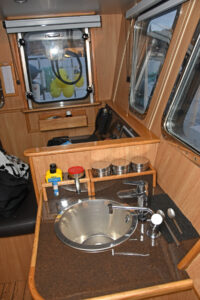
Hot drink facilities and a desk area are included to port.
Steering and navigation are taken care of by a Navitron NT921 MKII digital autopilot, together with an NT990 follow-up lever, remote rudder indicator and watch alarm with motion sensor.
Communications and safety equipment includes a Sailor 6310 150W GMDSS SSB radio telephone, Sailor VHFs, Icom GM1600E GMDSS handheld VHF, JRC Navtex receiver, Phontech 10-station internal intercom, Excel@Sea 60cm Ka-band VSAT system, and Intellian I6PE satellite TV system.
Echomaster Marine also installed an eight-channel IP CCTV network video recorder complete with eight cameras, in addition to an HD hull-mounted camera to view the vessel’s ropecutter-protected propeller and rudder.
High- and low-level alarms for the vivier tank overflow are also fitted.
A touch-screen control panel displaying digital information on tank capacities, vessel alarm systems, etc, which was installed by the yard, is fitted at the desk area.

